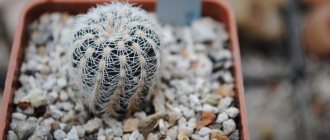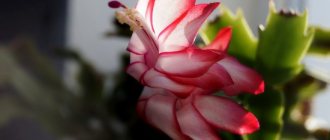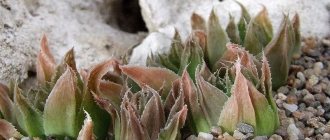Agave is a plant that belongs to a subspecies of succulents, or, more simply, cacti. They are a rosette of leaves, along the edges of which there are small spines. The greens of this subspecies have a dense, fleshy texture; it allows them to retain moisture for a long time, due to this they survive in the hottest climates. In nature, agave can be found in Central America. Like all succulents, this plant is used in the production of tequila. The blue subspecies is especially suitable for these purposes. Agave is also known for its medicinal properties; its pulp and juice have an antiseptic effect. The Chinese choose American agave juice for homeopathic ointments.
It blooms extremely rarely, for which it received the nickname agave. Some species actually bloom only once every fifty or hundred years, but for most the period before throwing out the peduncle is from ten to fifteen. It appears on a separate long stalk, which sometimes reaches up to nine meters; the flowers bloom gradually over almost a month. After the end of this cycle, the rosette from which the flower arrow appeared dies. But new shoots are appearing. After complete death, it is better to remove the faded rosette so as not to cause rotting.
Planting/growing
This beautiful ornamental plant is very large in size, which is why flower beds in the garden are much more suitable for them. The height of some species can reach up to three meters. At home, dwarf forms or young plants are grown for replanting.
The conditions for growing agave are simple; you need to create a climate similar to a desert. The light should not only be bright, there should be a lot of it. A complete absence of shadow is desirable. Therefore, it is better to keep flowers on the south window. If we consider that in its homeland the flower grows in an absolutely dry desert climate, then direct sunlight not only does not harm it, it is simply necessary. Therefore, choose those windowsills for agave that receive a lot of sun during the day. Even in summer, under the scorching rays, it feels great.
Temperature
The temperature in the room should not be lower than 18°C , the upper threshold is 28°C. Agave is a heat-loving plant; the apartment or house must be well heated for the plant to feel comfortable.
If the radiators give you a strong fever, hang a thermometer near the window opening. But rarely when additional protective measures are necessary, agave loves warmth and grows better in it .
The flower benefits from ventilation, but if the temperatures drop to 10°C, the agave may die.
Humidity level
to spray the flower . Do not place bowls in water or a humidifier nearby. Usually, apartments have dry air, which is almost native to agave in its natural habitat.
If the sockets become dusty, you can wipe them with a damp cloth or rinse them with warm water. Do not forget to dry the sockets after this, otherwise stagnant water will cause rotting of the leaves and roots.
Care
In the summer, agave feels comfortable outdoors. Therefore, if you live in a country house, then it is best to take the plant outside for the summer. In winter, it needs a bright place, otherwise, when dormancy sets in, the agave will begin to grow upward, the foliage will fade and lose its attractiveness.
Using these same signs, you can determine how comfortable the living conditions are for your cactus. A south-facing balcony or loggia is perfect for growing.
Description
It comes in several types. The most popular is the American agave (Agave americana). The flower is more than 3 meters in diameter with a height of 1-2 meters. The stem is shortened. It is characterized by large, fleshy leaves of gray color with a green or blue tint, collected in 20-30 pieces in a basal rosette. Curved in an arc and tapering towards the apex, ending in a spike. The upper side is flat, covered with a waxy coating, the lower side is convex. In the natural environment, the leaf length is 2.0-3.0 meters. When artificially grown in favorable conditions - 1.0-1.5 meters, width - 25 cm. The edges are framed with prickly teeth.
Temperature
The temperature of the air in the room is not of decisive importance. But the most comfortable temperature is considered to be no lower than 18, optimal 20-22 degrees. In winter, the plant feels good even at 4-10 degrees. This allows you not to cover it outside during warm winters. When planting a flower, pay attention to the presence of drafts; they do not cause much harm, but they do not bring any benefit either.
Like other indoor flowers, the correct temperature regime and sufficient lighting are determined by the intensity of the color of the plant. If it fades or the leaves become more shrunken, then you need to change the conditions for the indoor flower.
Benefits of agave
Agave is not only an interesting flower, but also very useful. Helps cure diseases of bones and joints.
A tincture of Agave americana leaves is used to treat rheumatism. It is prepared as follows. Crushed leaves are poured with 40-70% alcohol or vodka at a ratio of 1:10. The mixture is tightly closed and kept at room temperature for 7 days. Then filter and pour into a dark bottle. Used for rubbing against rheumatism to cause a rush of blood to the affected area.
On a note!!!
Before using the tincture, you should check whether there is an allergic reaction to this product. First, you should anoint a small area of the skin; if redness does not appear, you can safely use the product.
Watering
The watering regime is similar to all cacti, that is, quite rare, but regular. The frequency of watering also depends on the temperature around the flower. In summer, the number of water procedures is increased to 1-2 times a week, depending on the ambient temperature. In winter, if the air does not warm up above 10 degrees, then once every two weeks, or even a month, will be enough. Just like any other flowers, agave slows down its growth in the winter season.
All cacti are quite unpretentious to the presence of moisture, so irregular watering will not be a disaster for the agave. But at the same time, the flower will simply grow, rarely delighting with shoots, and even more so with flowers that appear infrequently anyway.
Seeds
The seed method takes longer than the vegetative method. Sowing is done in February. Seeds are sown in rows in long boxes with loose, moist soil. Sprinkle the top with a low layer of soil. In order for the seeds to germinate faster, you need to create greenhouse conditions. To do this, the containers are covered with film or glass and placed in a warm, well-lit place. Recommended temperature: +22°C.
Caring for crops involves daily airing and moistening with a spray bottle as the soil dries. Seedlings appear after 7–10 days. When young plants have 5 leaves, they need to be planted in separate pots.
Until six months of age, succulents should be grown in indirect light. Then gradually they need to be accustomed to bright lighting.
Leaves
During vegetative propagation, a large healthy leaf should be cut off at the base. Then it needs to be dried for 4–5 hours, and then planted in sandy soil. Rooting of the leaf should occur at a temperature of +21°C. Before the cuttings are completely rooted, they need to be watered moderately. Young leaves should form after a few weeks.
Offspring
At the base of the trunk, suckers periodically appear. To separate them, you need to remove the mother plant from the pot. Then cut off the shoots with a sharp knife. Transplant the old plant into new soil. Leave the shoots for several hours to allow the cut area to dry. Then treat it with crushed coal, plant the “baby” for rooting in pots with moistened sand and place it in a room with a temperature of +20°C. Succulents need to be watered periodically. In the first week, moisturizing should be done frequently and generously. Then it is enough to irrigate the soil once every 3 days.
When the plant has formed a strong root system, replanting will be required. At first, it should be protected from direct sunlight.
Reproduction
Agave propagation occurs in several ways:
- seeds;
- cuttings;
- young shoots.
The seed method occurs somewhere in February-March. The seeds are buried by 1-2 cm. The temperature should be within 20-25 degrees. Therefore, at the first stage, you can cover the pot with film, but during the day you need to open the “greenhouse” and ventilate it. The result can be seen in two weeks, at which time picking and fertilizing are carried out.
Vegetative methods (cuttings or shoots) are carried out as necessary, regardless of the time of year. The shoots are separated with a knife or simply broken off. Before putting the sprouts into the ground, they need to be dried. A dried cutting area can be a good guide for the gardener. The soil substrate is akin to an adult. You need to water it for the first time no earlier than a week later, and “feed” it, like adults, once a month.
When planting the shoot in the ground, leave some roots on top. It is good to secure the flower with pebbles or shells. There is no need to press them hard into the ground or press them with your fingers. The presence of a root on top will ensure proper moisture and air exchange.
How to successfully replant a succulent
Since the root system of the indoor plant grows and becomes cramped in the pot, and the soil becomes depleted over time, the plant must be periodically replanted into a new container and soil.
Young succulents should be replanted every year. Mature specimens can be replanted once every 2–3 years. The pot and soil of those plants that have already celebrated their tenth anniversary should be changed as needed. The recommended method of transplantation is the transshipment method. The best time is the beginning of spring. For agave, a pot with a diameter equal to the height of the plant is suitable. Some species and varieties prefer to grow in wide and low containers.
When transplanting, you should follow these instructions:
1. A day before the procedure, moisten the soil well.
2. On the day of replanting, remove the plant from the pot, lightly but not completely cleaning the soil.
3. Place a high layer of drainage made of expanded clay, broken brick chips, and pebbles at the bottom of the new container.
4. Pour in the pre-prepared soil mixture, filling ¾ of the pot with it. Recommended composition: 3 parts sand, 2 parts humus, 2 parts garden soil. Commercial soil designed for cacti and succulents will also work.
5. Place a lump of earth in the center.
6. Fill the pot with soil to the top, leaving 1–1.5 cm from the edge. It is important to ensure that the root collar is located above ground level.
7. Moisturize.
8. Sprinkle with coarse sand.
Regular and correct transplants in combination with monthly fertilization and maintaining favorable conditions when maintaining indoor culture allow you to achieve maximum growth rate and decorativeness of the succulent.
Transfer
How to replant an agave? Replanting will allow the plant to send out new shoots and shoots, as well as ventilate the root system and avoid acidification of the soil. For young shoots, replanting is of great importance and is therefore done once a year. In older specimens, soil change occurs every two to three years or as the flower grows. Drainage is required to retain moisture. The soil itself is mixed in the following proportions:
- one part is coarse sand;
- another leafy one;
- the rest is filled with a clay-turf mixture, approximately three-fifths of the total amount.
It is better to take wide pots as a flowerpot, since the size of the rosette is quite large. The root does not need to be deeply buried in the ground; it is enough to leave it on the surface. It is better to secure the flower rosette itself with pebbles. Sprinkle with sand, gravel or shells. This form of planting will not only allow the roots to be in their usual environment, but will also provide moisture retention and protection from temperature changes.
Soil selection
In the wild, agaves are accustomed to sandy and sandy-rocky soil . You can buy special soil for succulents (yucca, dracaena, palm trees) at a flower shop, or prepare it yourself. To do this you need to take:
- 3 parts clay-turf soil;
- 1 part leaf soil;
- 1 part river sand.
Experienced gardeners advise adding lime, charcoal and bone meal to the sand, which are necessary to disinfect the soil and increase fertility.
Diseases and pests
The main enemies of this cactus are considered to be thyroid gland, aphids, thrips and spider mites.
The thyroid gland is a small insect, ranging from 1.5 to 4 mm. They cover the bottom of the leaf. They can be of different shades: from yellow to red-brown. This is a parasite that feeds and grows from the sap found in the leaves. One of the signs of damage is the appearance of stickiness. Adult parasites are protected from exposure by a thin chitinous layer. The best protection against them is to wipe the leaves with a cloth or sponge with a concentrated soap solution. If prevention was not done on time and the pests have spread greatly, then it is better to prune the diseased greenery.
When aphids are infested, spots appear on the leaves - these are places where insects grow. Most of them are green. She multiplies quickly. With severe damage, the leaves wrinkle and gradually die. Known methods of control include wiping and spraying the leaves with a soap solution. But only adult insects can be destroyed in this way, so during the treatment period, agave needs to be treated every two to three days.
Thrips leave behind silvery trails as they crawl. The leaves turn yellow or become completely discolored. Pests are very dangerous for flowers. To combat thrips, warm water is sufficient. In case of severe damage, use karbofos emulsion.
Spider mites are one of the most dangerous enemies of all indoor plants. It is easily recognized by the presence of a small thin web on the plant. In this case, the foliage deteriorates, becomes dull, and young shoots quickly die off. For destruction, very concentrated soapy water is used, ventilation and spraying are organized.
Instead of soap, in all cases you can use beer or alcohol solutions, but when using the latter you need to be careful not to burn the plant. If home methods do not help, then chemicals may be used.
Caring for agave does not require much effort or attention. This flower is perfect for apartments that “suffer” from excess light, and for open spaces in the garden. If you manage to create comfortable conditions for her, she will reciprocate and will delight you with a lot of greenery. Be careful and constantly inspect the flower - this will make it possible to detect the disease in time.
| Growing | Can be grown at home and in the garden. |
| Humidity | Easily tolerates dry climates and is not additionally moistened. |
| Feeding and pruning | Feed the flower once a month, cutting off only diseased leaves. |
| Flowering period | Once every 10-25 years, less often - every 50-100. |
| Landing, transplant | If necessary, about once a year. Seeds are planted in February-March. |
| Reproduction | Seeds and shoots. |
| Pests | Thrips, scale insects, spider mites and aphids. |
| Diseases | Brown spots in places where pests live. |
Healing properties
Having an agave bush at home, you can always use its leaves for medicinal purposes.
For abscesses
Tear off a leaf, split it and apply the cut to the abscess. After some time, you may feel a burning sensation in this place. It's not scary. You just need to be patient to get relief from the disease. You can relieve irritation by applying a little fresh cottage cheese after the lotion.
For stomach diseases
An infusion is being prepared. Chop the fresh leaf with a knife, pour a glass of chilled boiled water. Let it brew for 6 hours. After this, you can use 1 tbsp. spoon three times a day before meals.
For people with liver problems, the infusion should be prepared not from a fresh plant, but from dried powder. To do this, tear off the leaf from the rosette, cut it and let it dry. Then grind finely. Take the minimum dose on the tip of a small knife each time before meals.
For bronchitis
Squeeze the juice out of the leaves, mix with honey and take orally in small portions.
Habitat
The American's homeland is Mexico and the American states of Texas and Arizona.
As an ornamental flower, the agave quickly spread throughout the world. Its modern habitat is China and Korea, New Zealand and Australia, the Mediterranean, India, Africa, Thailand and South America.
American agave is a very useful representative of the flora. The leaves have a hemostatic effect, and the juice has a diuretic and laxative effect.
In Mexico, agave is eaten and used in making soap.
Some subspecies of agave are distinguished by a decorative light stripe that runs along the middle or sides of the leaf blades











